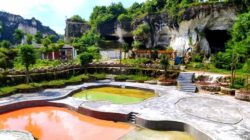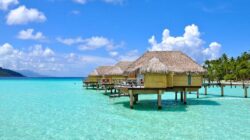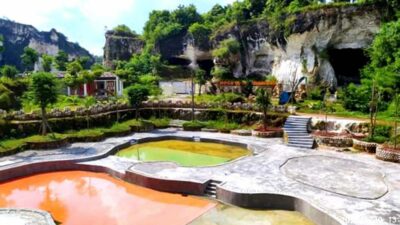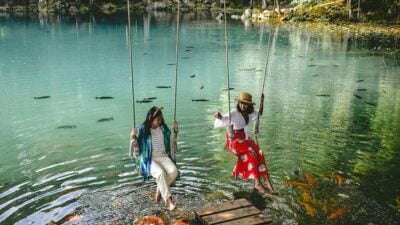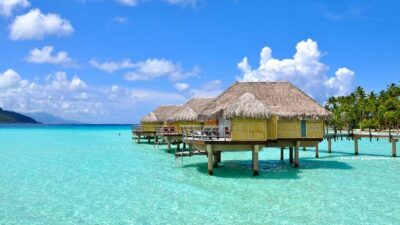For those who have visited the capital city of Jakarta, they must have taken the time to visit one of the iconic monuments in the city. The National Monument is a commemorative monument used to honor the struggle of the Indonesian people in achieving independence from the hands of colonizers. This towering structure stands at a height of 132 meters, located in the center of a park. To find this building, one simply needs to visit Medan Merdeka Street in Central Jakarta.
The National Monument of Indonesia, source: www.layoverguide.com
The construction of the National Monument started on August 17, 1961. Built during the presidency of the first president of the Republic of Indonesia, Ir. Soekarno, it was opened to the public on June 12, 1975. When visiting this place, you will come across various historical documentation of Indonesia’s struggle in the past, displayed through reliefs. Additionally, there is a room of independence and a museum that houses historical documents of the Indonesian State.
During the Dutch colonial period, the capital of the Republic of Indonesia was once in Yogyakarta before moving back to Jakarta after the Dutch government recognized the sovereignty of the Republic of Indonesia in 1949. After this event, President Soekarno planned to build a national monument in order to preserve and commemorate the struggle of the Indonesian nation, hoping to inspire and develop the spirit of patriotism in future generations.
The beauty of the National Monument is evident during the daytime, source: vacationio.com
On August 17, 1954, the Indonesian government formed a national committee to plan and build this monument. In 1955, the national committee held a design competition for the construction of the National Monument. At that time, numerous designs were submitted, totaling 51, and only one met the criteria set by the national committee. The design that met the criteria belonged to Frederich Salaban. In 1960, a second competition was held, and 136 designs were submitted, but none of them met the criteria. As a result, the jury requested Frederich Silaban to submit his design to President Soekarno. Unfortunately, Silaban’s design was not liked by President Soekarno, as he envisioned a monument in the shape of a lingam and a yoni. Silaban was then asked to create a new design that aligned with the President’s vision. He submitted another design, which had extraordinary specifications that required a significant amount of funds for its construction. However, at that time, Indonesia had just gained independence and the economic conditions were not yet favorable enough to construct the monument according to Silaban’s proposed design. As a result, Silaban was asked to design a smaller version, but he refused and suggested that the government postpone the construction of the National Monument until the country’s economy improved.
On August 17, 1961, the construction of the National Monument finally commenced with the inclusion of R.M. Soedarsono in the architectural team, alongside Friedrich Silaban. One of Soedarsono’s ideas in designing Monas was to incorporate the numbers 17, 8, and 45, which symbolize the Proclamation of Indonesian Independence.
The construction process of the National Monument consisted of three stages. The first stage took place from 1961/1962 to 1964/1965 and involved the construction of the monument’s foundation, which required approximately 284 concrete piles. The foundation for the museum was built with 360 earth piles. The foundation construction was completed in March 1962. The second stage of construction took place from 1966 to 1968. This stage was significantly delayed due to the tragedy of the September 30th Movement (G-30-S/PKI) rebellion. The final construction stage took place from 1969 to 1976, but there were still difficulties that resulted in the delayed opening of the museum to the public. This was due to several leaks on the building’s roof. The National Monument was officially inaugurated on July 12, 1975, by the President of the Republic of Indonesia, Soeharto.
The route to Monas is quite easy to navigate as it is located within the city. If you are coming from outside the capital, you can use air transportation and transit at Halim Perdana Kusuma Airport in Jakarta, then continue your journey to Cawang UKI using public transportation. Once you arrive at Cawang UKI, you must continue your journey to Cempaka Mas 2 by taking a bus with the Tanjung Priok route. From there, you can transfer to Cempaka Timur Bus Stop, then take another bus with the Harmoni route and get off at Gambir 1 Bus Stop. From there, you can take a short walk to Monas. If you are transiting at Soekarno-Hatta Airport, you can take a Damri bus with the Airport-Gambir route and get off at Monas.
Visiting Monas in the afternoon and strolling through the park is a popular activity among visitors. People often spend their time taking photos while enjoying the surrounding views. Some visitors also enjoy biking with their family, friends, or loved ones. Additionally, you can admire the beauty of Jakarta from the top of Monas by taking the elevator to the summit. The Monas management also provides telescopes for visitors to have a closer look at the panorama of Jakarta. However, the summit of Monas can only accommodate approximately 50 people, so it is advisable to come in the morning to experience this.
At the peak of Monas, there is a gold-plated Flame of Independence, symbolizing the burning spirit of the Indonesian nation, source: www.youtube.com
In addition to enjoying the panoramic views of Jakarta from the top, you can also view historical reliefs outside Monas. These reliefs depict the ancient glory of the Nusantara, including the






